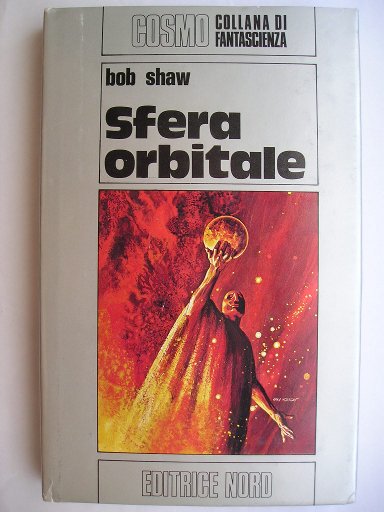
The novel “Orbitsville” by Bob Shaw was published for the first time in the magazine “Galaxy Science Fiction” in installments between June and August 1974 and as a book in 1975. It’s the first novel of the Orbitsville trilogy.
Vance Garamond is the commander of a Starflight House starship but the tyrannical company president Elizabeth Lindstrom treats all her employees as servants. As a result, it happens that Vance is used as a baby-sitter for the president’s son. It’s not a job for a captain but in theory it’s very simple, so much that Vance gets distracted and an accident causes the child’s death.
Elizabeth is known for killing people on a whim so Vance knows that her revenge against the man considered responsible for her son’s death would be terrible. Desperate, before someone notices what happened, he runs to fetch his wife and son, flies to his starship and leaves as quickly as possible. Pursued by other starships of the company, Vance decides to go to a star where some people say there was once an alien civilization and finds a Dyson sphere.
The concept of a sphere that completely surrounds a star to capture all the energy that it emits was theorized by the English astronomer Freeman Dyson in 1959. However, that was a concept that Dyson admitted he had developed after reading the science fiction novel “Star Maker” by Olaf Stapledon, published for the first time in 1937.
“Orbitsville” is often compared to the novel “Ringworld” (1970) by Larry Niven, set on a ring-shaped structure surrounding a star. The comparison is due mostly to the this novel’s fame because there are many differences with Bob Shaw’s novel and at that point you could make comparisons with other stories based on those concepts written in those years.
In “Orbitsville”, a Dyson sphere is discovered by the crew of the starship Bissendorf. The first part of the novel, about a third, is the story of the Captain of this starship Vance Garamond and his escape with his family from the vengeance of the despotic and ruthless Elizabeth Lindstrom.
In a future where interstellar travel is common, the Earth is still overpopulated because only one planet suitable for human life has been discovered and colonized. Elizabeth Lindstrom has no interest in finding other planets to colonize because she earns huge amounts of money by controlling the colonization of a single planet. This all changes with the discovery of the Dyson sphere.
About two-thirds of the novel are devoted to the early exploration of this immense sphere, officially called Lindstromland but unofficially called Orbitsville. Bob Shaw develops in his own way this concept proposing the idea of the Dyson sphere built by an unknown alien species as a kind of trap for sentient beings.
Orbitsville is stunning in its vastness but because of this it ends up becoming almost dull. Its various local geographical features end up being blurred when you try to see a sufficiently large part of the sphere at the same time. For the Earthlings, the space that can be colonized is like infinite therefore, coming from the major problems of the home planet, everything seems very simple, even too much.
Discovering Orbitsville, Captain Vance Garamond sees a chance to save himself and his family from Elizabeth Lindstrom’s vengeance but he knows that he can’t be complacent because an attempt to kill him and his family can be carried out with discretion any time.
This struggle for survival by Captain Vance Garamond goes on throughout the novel. Bob Shaw had already put negative female characters into some of his previous stories, in “Orbitsville” there are two of them. Elizabeth Lindstrom is basically a psychopath who’s in a position of enormous power but there is also Aileen, Captain Vance Garamond’s wife, who is really stupid and for that reason risk her life and her son’s.
Bob Shaw considered the characters in his stories very important so in “Orbitsville” they’re well developed. There’s a strong plot connected to them, as if to compensate for Orbitsville’s impersonal vastness. However, this ends up taking away room from the exploration of the Dyson sphere in a novel that by today’s standards is quite short. Today we sometimes complain about novels too long but Shaw published his novels in a market where the standard was less than 200 pages, which in cases like this are not enough.
Nevertheless, in my opinion “Orbitsville” is a good novel that contains an intriguing vision on the subject of the Dyson sphere. Also considering that the story concerning Orbitsville is developed in its two sequels I recommend reading it.


Permalink